#I do like making isometric maps but
Note
So what's Gigantic?
One of my favorite games ever made, and one I thought lost forever until now.
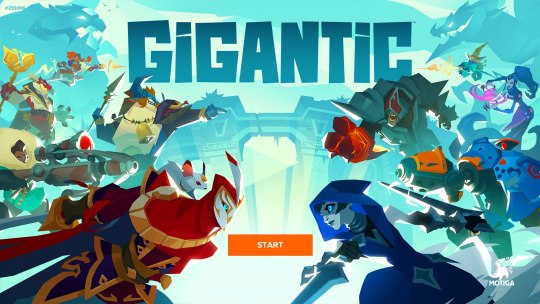
Gigantic was a free to play 5v5, third person action game released on PC back in 2017, though I first played the game back in 2015.
A weird and wonderful mix of MOBA mechanics, platforming, and third person action game combat, a match of Gigantic tasked each team with destroying the other team's Guardian to win the game.
Now in a traditional MOBA like Dota or League of Legends, this objective would be a building. In Gigantic however, the objective is a massive kaiju, willing and able to squish you underfoot. How are you supposed to slay a beast the size of a building you ask? Simple. You use your own.
Each match in Gigantic is a race to empower your Guardian faster than the other team. This can be done by capturing checkpoints and placing a creature on it to start mining for power, killing other players to steal their power, or the ballsiest move—attacking the enemy Guardian to steal the power it's already got, preferably avoiding the laser beams it fires from its eyes to fry you on the spot.
Empower your Guardian enough and it will rampage across the map, bulldozing over enemy players and smacking the enemy Guardian with an earth-shattering strike. While your Guardian has the enemy Guardian pinned down, you can then attack it to deal damage without it being able to fight back. However, even an empowered Guardian cannot keep the enemy's Guardian pinned for long, and once it breaks out your own Guardian retreats, and the power race begins anew.
But a MOBA game is nothing without its cast of characters, and on that end Gigantic had among the best in video games. These were just some of the many incredibly varied, gorgeously drawn faces you could find.

These guys made the most out of their medium being in 3D rather than the isometric top down view of most MOBA games, with many having skillsets greatly inspired from a wide variety of different genres, from first person shooters to fighting games.
That woman with the eyepatch? That's Imani. A classic sniper character, her gimmick was that her skills changed what sort of ammo she carried, from regular crossbow bolts, to freeze bolts, to fire bolts, to bombs. Imani's unrivaled range meant she could take over parts of the map that were too open, while her ammo types gave her utility to help her team with rather than simply be a DPS bot.
The frog? That's Wu. A proud fighting game reference, he could do a tatsumaki, a rising flip kick, even a shoryuken for his Focus move (ultimate).
Now the thing about Gigantic's combat is that rather than go the MOBA route of building items and increasing stats as you level up to get stronger, Gigantic instead went for the action-game approach. There were no item builds or gold to consider, and rather than mana, every character had a stamina bar that was used to activate skills, but also allowed each and every character to dodge, sprint, and jump around. Levels were merely to put in more skill points that added new features to your existing moves rather than to increase your stat lines. Good stamina management and clever movement could allow you to dodge an entire team's worth of skills, and the lack of gold or items meant you could never be too far behind to outplay a stronger opponent. I've come back from near impossible matches where my Guardian was on a sliver of health while the enemy's Guardian was untouched, all from the team rallying and playing to the absolute best of their limits.
If you would like a more visual explanation, here's a quick introduction to the first character in that picture, the acrobatic assassin Tyto the Swift.
youtube
And over here is a video of a full match featuring somebody playing that character as a hypermobile assassin, leaping all around the map, making fine use of verticality and enemy blind spots to swoop in, deal damage, and get out.
youtube
I'm so glad Gigantic is back. it can't be allowed to die again.
215 notes
·
View notes
Text


Sometimes I’m just so overwhelmingly grateful I am an artist and I can do fun stuff like this as a DM for my campaign 😭
I’ve discovered the world of isometric maps and I think they’re super fun for online dnd games where you still want to feel like you have minis. There’s not a lot of customizable isometric ttrp stuff I’m personally drawn to out there so I decided to make my own tile sets and will slowly start making monster tokens and stuff. Not to plug myself but this is why I’ve decided to open a ko-fi soon so I can share the tile sets and tokens I end up making 🙈
#if you’re seeing this my players NO YOU DIDNT#dnd npc#dnd homebrew#dnd campaign#dnd character#dnd maps#dungeons and dragons#dnd art#dnd dm#dnd token#ttrpg#dnd#lo art
205 notes
·
View notes
Note
Do you happen to know any other games like transistor or Hades? sorry if it's so random but I got into them thru seeing them on your blog and have been looking for something along similar gameplay
if you haven't already, check out the rest of the Supergiant catalogue? they're also isometric action games, and although I haven't played them myself I hear good things:
Bastion—truthfully I tried this one and just couldn't get into it but it does look pretty and has good voice acting like all SG games
Pyre—honestly I've been meaning to play this for a while but I just haven't gotten around to it. it has middle child syndrome in that it gets looked over for its move hyped siblings but everything I've heard about it has been positive
I don't know if I can recommend anything with similar gameplay to Hades and Transistor, because I don't play a lot of roguelites and Transistor was so unique I'm struggling to think of a comparison. Supergiant has been really singular for me in combining storytelling with gameplay, the marriage of the two in Hades in particular I think was a masterclass akin to Portal (which I'd also recommend if you haven't played it). so a lot of these recommendations are just going to address parts of what I liked about Hades and Transistor, but not the whole package, really.
story-heavy RPG-light games with beautiful graphics with no combat:
Oxenfree—supernatural/coming-of-age story about a group of kids trapped on an island when a portal opens to another world
Night in the Woods—the story of Mae, a college dropout struggling with mental health, who moves back home to deal with friend and family problems... and something else that's in the woods
Afterparty—two friends die and get sent to hell. they hear the only way to escape is to challenge the devil to a drinking contest, so they travel the afterlife to do just that
Signs of the Sojourner—this is an interesting one where you travel to acquire goods to sell at your shop, but negotiating is difficult, and the cards in your deck will help you succeed in forging bonds in conversations. the more diverse cards you have, the more people you can interact with successfully, but you also risk losing the cards you started with, which will make your conversations back home difficult when you return to stock up.
action-heavy indie games, usually made me go "just one more map":
Apotheon—story set in a 2D Greek mythology world about a man challenged to take down the pantheon one god at a time
Into the Breach—the only other roguelite I've played, it's a turn-based strategy where you fight aliens on a grid system with robots, very Pacific Rim-esque
Cult of the Lamb—a roguelite about running your own cult full of animals. apparently it's big on the horror elements without being off-putting or too gory due to the cute graphics. I haven't played this but other people have recommended it!
Jade Order—a very short puzzle game with a neat map design
46 notes
·
View notes
Text
Here's what I've been up to!
Are people returning to tumblr?? That would make me so happy!
I've been doing a lot for the past couple years! Aside from my career as a tattoo artist, I've been doing a lot of art of Dungeons and Dragons, and after drawing fanart and commissions for d&d for years, I finally started playing! One of the major things I've started doing is drawing map and token assets that can be used for digital tabletops, like roll20. I do top down assets and lots of bust-style tokens, but my favourite thing to do has been isometric assets.
My maps and tokens are for sale on roll20 and patreon, and I've also got a tiktok where you can see them in motion and find out how to use them in your game! It's really not as complicated as it looks, and I find the isometric maps add a lot to my game.
I also have some plothooks, npcs, villians, and traps on my tiktok and patreon that you can use in your own game, and you can learn about my magical girls/horror home game.
Here are a few examples of maps and tokens I've done!
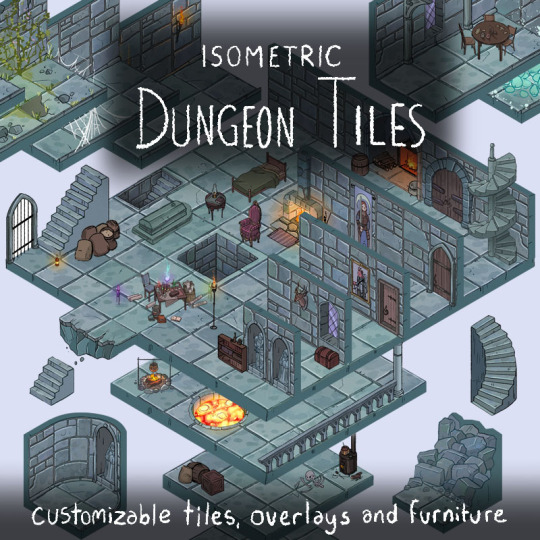
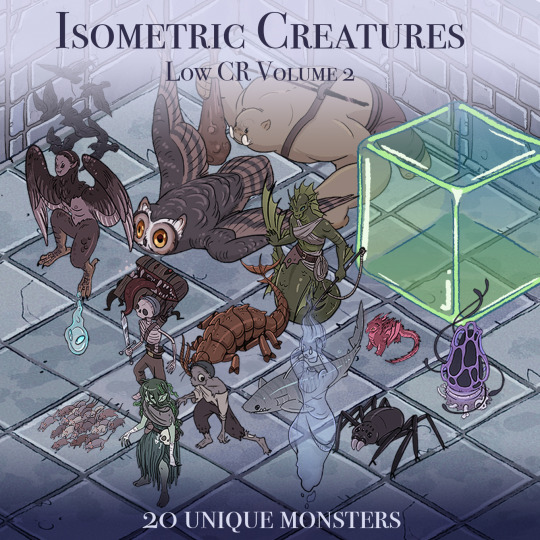
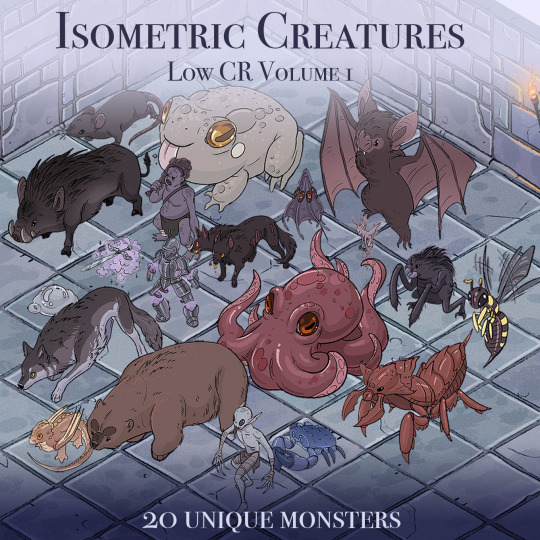

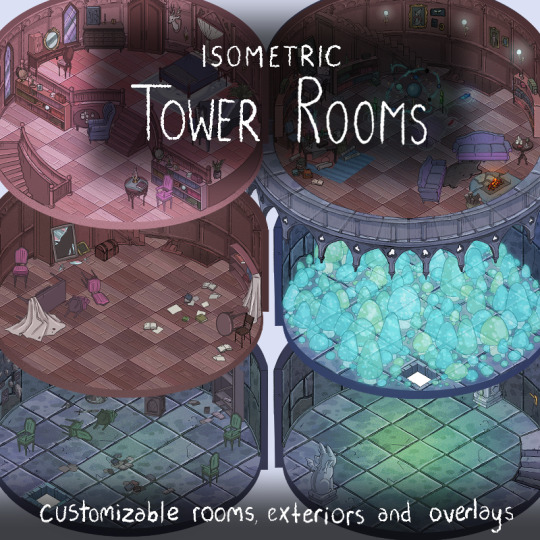
#dnd map#dungeons and dragons#dnd#d&d#d&dmap#isometric map#isometric art#dnd art#dnd5e#dnd stuff#dnd maps#dnd mapmaker#dnd monster#dungeons and dragons maps#dungeons and dragons art#dungeons and dragons tokens#roll20#ttrpg#digital ttrpg
173 notes
·
View notes
Text
Red panda and bunny- forest walk and tale of big moth
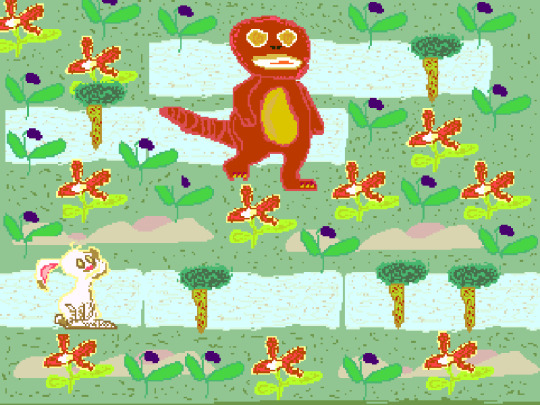
Pixel art for today based on videogame Barneys Hide Seek Game for game console Sega MegaDrive. Game about 1993 year. About dinosaur Barnie. It is based on cartoon.
And this is my drawing about the same theme. Red panda and little bunny. I think in my imagination about something isometrical somekind of action. Action game. Where there are such kind animals. They are jumping and doing it rather dynamically. You are – red panda. And you have a friend little bunny. You are together are going through different zones of forest. All the game - it is forest. And you can go free by map. As in Jungle Strike. Up and down, left, and right. And collect vegetables and plants.
From one had it is about good and kind theme, and from another hand – it is little crzy style. It is not comix zone of course. But a little like zombie ate my neighborhood.
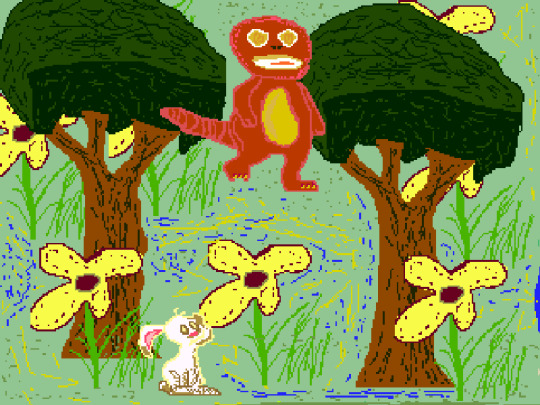
Red panda in travelling the forest. Looks at big butterflies. And speaks with bugs. All animals are intelligence here. They have their own magical world. Big moth tells a tale to red panda about wonderful river. You can swim and find a new friends – fish. Red panda is searching for a road to this place. Though all the forest. Big butterfly is flying all over the place. And know everything about the forest.
And every evening all animals are friendly goes to rabbit with a hat. You also can go to drink a tea with giant moth, rabbit with a hat, red panda and bunny. Everyone is telling some tales, or sit and listen to them.

Dima Link is making retro videogames, apps, a little of music, write stories, and some retro more.
WEBSITE: http://www.dimalink.tv-games.ru/home_eng.html
#8 bit#16 bit#ms dos#retro#retro art#2d art#pixel art#gamedev#indidev#red panda#little bunny#big moth#butterfly#fish#river#forest#adventure#action#arcade#collect items#vegetables#cartoon#dinosaur barnie#kind animals#good animals#travel#tree#grass
22 notes
·
View notes
Note
I always love hearing about other people's D&D games and I was wondering if you had like a method for how you plan out your sessions? In a slump rn myself so looking for some inspo lol
ok so i need to get better at this again (depression made me a way more 'seat of my pants' DM) BUT i basically lay out a "timeline" of main story points the party will eventually hit, and place "questlines" there. Essentially like a tree of quests and their progression in a videogame. This is NOT always detailed by any means but it helps me get a linear view of what's going on. If you run pre-made modules, this is the book stuff. My current game started out this way before I went "I like doing this myself" and went completely off the rails.
Then I go into the main details of the questline. Stuff like where it is, if there's going to be new lore introduced, the actual contents of the quest itself and it's requirements, etc. My players and myself are big on RP, so I also try to always make sure the quest will have interest for Story or Character reasons. If it doesn't directly push the plot in a major way, will it still give the party interesting interactions with each other and npcs? Are there going to be any new threads for some of the game's mysteries?
Then I also ask what in the questline is going to play to the party's habits and strengths. I admit this is WAY looser, and again kind of wraps around into "what would be cool RP for them" - but for example; knowing an encounter with nobles will give our noble-born artificer some additional lore, since he understands the city's politics.
After that, I do sometimes "script" certain lines of NPC dialogue or location and item descriptions. Stuff I'll be narrating that I want to make sure has a certain weight to it, or to flow well. You might not need to do this if you speak succinctly, but I find my brain stutters when trying to describe scenery on the spot, so it usually helps to write it. After that I make the session from there!
For me that usually includes picking out "splash screens" for the conversation backgrounds in our game, drawing new npc portraits if I have the time (it started because some of my players have aphantasia/some former players were new, so I drew PC and NPC portraits to make RP easier to visualize - then it just became the Only Way I Want To Do It Now LOL), and making maps. I use Epic Isometric for my maps, highly recommend. I get most of my splash screens from Art Station, but I have to say obviously that's unwise if you're streaming a game. Same goes for using pre-existing art as character/NPC art -- I know myself and other artists don't care if someone uses our stuff for their home game that no one's ever gonna see. I plan to release some of my portraits in packs one day free of use though.
Here's the RP Backdrop kind of splashscreen I use in R20 (but you can make one in FVTT too, I've done it) and an Epic Iso map I threw together (the party tokens were drawn over Epic Iso assets. If you join their discord people make community edits constantly. I'm currently working on a project to color all the released decor assets)
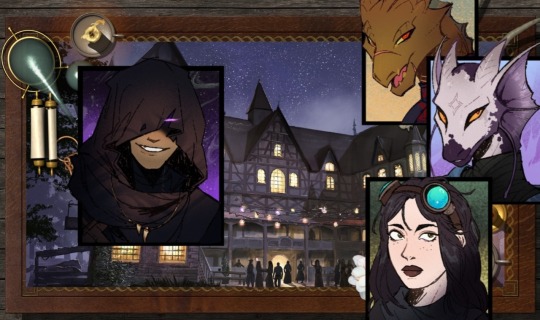

34 notes
·
View notes
Text
I'm struggling a little bit to find the right 'data type' for a scissors morphism (of which a scissors congruence would be an isomorphism) in an arbitrary category C. Because the arrows of C aren't necessarily functions, you can't have a scissors morphism just be a more lax notion of function. The heavy handed way to do it would be to have a scissors morphism be an indexed family of C-morphisms, defined on a covering family of its domain object, satisfying certain coherence properties (this is how Zakharevich does it, or something like it). But that feels bad! It's too extrinsic, and I think you run the risk of having multiple morphisms for what 'should' be the same action.
One thing I tried is to have it be a specific 'sieve correspondence'. A sieve is kind of like a subobject, except there's way more of them. Say your morphisms are inclusions of squares into squares in the plane. There's no subobject in this category corresponding to a disk inside the square, but there is the sieve of all squares contained within that disk. Specifically, you can identify sieves on an object with the subfunctors of the representable presheaf of that object. So you can say that the data type of a scissors morphism is a (possibly union-preserving, to make it function-like) action from the sieves on the domain to the sieves on the codomain!
There's an issue here, though. Including the C-morphisms as trivial scissors morphisms (for the covering family consisting of just the identity arrow) in this way is not generally faithful. If you have the category of polygons and isometric inclusions then it is faithful, because an isometry on a figure with interior is uniquely determined by its action on the subfigures (so certainly by the action on the sieves!). But for the cyclic group of order 2 considered as a one-object category you run into issues. The presheaves on this category are the C₂-sets and the unique representable presheaf is the two point set with the obvious action. This object has two automorphisms, but both have the same action on the subobjects, because neither of the points are invariant subsets on their own. So reducing to sieve actions is not faithful!
So famously one of the consequences of the Yoneda lemma is that the action on representable presheaves (i.e. homset functors with fixed codomain) of postcomposition by some arrow is a faithful representation of the category; if postcomposing by f, f': A -> B gives the same function Hom(X,A) -> Hom(X,B) for all objects X, then f = f'. The problem is that it is also full; all such natural transformations are given by some postcomposition, specifically postcomposition by the image of id ∈ Hom(A,A) (and that's the proof of the Yoneda lemma, by the way, that's why people say it's so simple).
So maybe just straight up transformations (sans naturality) between representable presheaves? That is, just a set function Hom(X,A) -> Hom(X,B) for every object X? The problem is that you then need to decide where id_A gets sent to. And the 'image' of a scissors morphism that you do want to exist might not be a subobject. Like, if your category only contains connected polygons, you still want the scissors morphisms to contain actions that disconnect the object. That's what scissors do! So again mapping it onto a sieve is perfect, since it contains exactly those phantom subobjects that you need to exist. You just need enough sieves to differentiate the C-arrows. But how to get them?
#math#this is not an effortpost to explain anything btw this is literally just me rambling about my research
16 notes
·
View notes
Text
NOMIA
Hi everyone, been a while! I'm making an isometric tactics game called NOMIA.
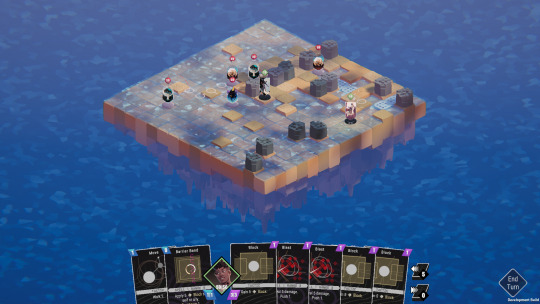
What's the summary?
It's Final Fantasy Tactics meets Slay the Spire.
It's about the characters I've been drawing, navigating a dreamlike world where things that fade from the collective memory coalesce into places and creatures. It's an exercise in making a cozy fantasy setting that explores lesser-seen worldbuilding elements.
What makes this unique?
I'm focusing on three things that I hope will make for a fun and unique experience.
1. Your hand has two halves.
The left side of your hand represents your Actions, which persist between turns, but have charges and cooldowns.
The right side of your hand represents your Gambits, which are drawn from a deck of cards each turn, and are discarded when played.
You can add to both decks over the course of a run, expressing your playstyle through character building as well as deckbuilding.
youtube
2. Your party has two heroes.
You'll always pick two at the start of each expedition -- a Mighty and a Magical.
The Mighty has more Actions.
The Magical has more Gambits.
youtube
Each has a unique deck of possible cards.
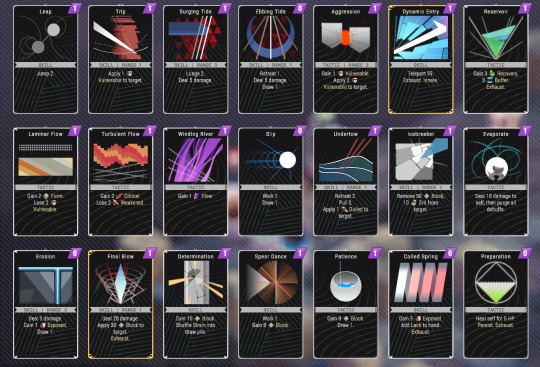
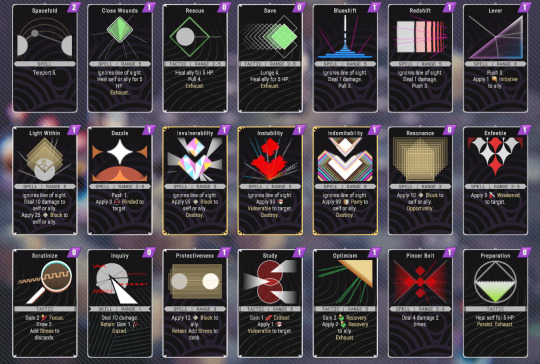
3. Your enemies have tells.
Enemy intents are shown on your turn, rewarding clever defense.
Intents are adjusted when you play cards, but not randomly; enemies have a goal in mind and will do their best to achieve it, allowing you to counterplay.
youtube
You can make enemies reconsider their target by attacking them. A character can play tank for their partner if they're in a pinch.
youtube
What am I working on?
I've spent roughly the last four months laying the groundwork for the card battle system, and figuring out a card creation pipeline and art style that would make it feasible for me, one (1) person, to make hundreds of unique and interesting cards.
I hope to achieve a sense of multiplicative game design -- that is, each aspect of the game creates synergies with the others, creating many possibilities and stories.
Next, I'll be working on run progression, and unique map/enemy generation for the different biomes I have in my head.
Thanks for taking the time to read my devlog!
---
(What does NOMIA stand for?
It stands for No One Makes It Alone. I am, ironically, making this alone. But I also like to think of it as a meditation on the fact that even in this situation, I'm benefiting from the work of countless people who have inspired me and laid the groundwork for what I'm trying to do.)
#indie games#gamedev#game development#nomia#oc: butterfly#oc: seagull#my art#my game development#Youtube
15 notes
·
View notes
Text
I am a happy girl. I’ve discovered something and I am a happy girl!
We all know how to make custom maps for TS2, right? Load up SC4, find a small city and then painstakingly use the janky tools to create a map that works for you while not being able to undo if you make mistakes or see your map in anything other than an isometric view.
I got really annoyed thinking about this because, for my new game, I want my map to look very specific dammit! I hate working in SC4 and then fucking something up because I sneezed and never getting it to look the same ever again.
I knew that you could generate Region Terrains using a grayscale image...but a TS2 map needs to be one Small City, not an entire Region, so how would I make that custom map work when I’d need the entire Region to be the size of a Small City? And then, could I just create my map in a 3D program so that I can dial in exactly what I want, geometry wise instead of having to fiddle in SC4 and just create a height map there?
WELP. I MADE IT WORK!!!!
I’ll write up a proper tutorial when I have the bugs worked out and know it works for sure, but for now...
First, I created a plane in 3DS Max with 64 segments square, this is the exact grid size you will be working with in SC4.

I used an in-game Neighborhood object to correctly scale the plane to match an actual overall ‘hood map. It was approximately 6′x6′ in Imperial Units.
Next I did some silly pushing and pulling to create some wild hills and valleys on the plane. I generated a height map from a top-down render and saved that out to be used later.

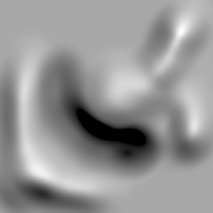
^ The Height Map
Next, I opened up the SC4 Regions folder and made a new Region. the Config.bmp image is the one that determines the layout of your region, this is how custom regions are made. I decided to try just making a region with a single small city to see what would happen...
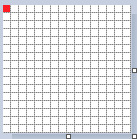
^ that red pixel represents one small city on a SC4 Region map. If this worked then I’d have what I needed (in theory)...

AND IT WORKED!!! Obviously very silly looking due to my just being in testing mode, but it works! Doing it this way means that it should be possible to just sculpt maps in 3D software so that you can get the look the way you want it and then do any fine tuning in SC4 once you generate the Terrain. The good thing about doing it this way (I think!) is that this should make it much easier to create world-specific CC like Neighborhood Deco that actually fits your world perfectly (more or less) because it’s all to scale and you can plan for it when sculpting the map.
Consider this the first entry in my “mortia builds a new game” series and I’ll be back when I’ve worked out the kinks :P
68 notes
·
View notes
Text
Tooning In 13. Greg Bailey Part 4 of 10

DL: Well. So how was working with Hanna Barbera again with Young Robin Hood?
GB:It was fine. Kind of like going back to my roots as far as working in animation went. On Robin Hood I was running the timing department and lip sync included. I went pretty smoothly from what I remember. It was a good chance to bring the US Saturday morning standards to a Canadian studio.
DL:The Busy World of Richard Scarry for Paramount/Showtime/The Family Channel and France Animation? How did that come to be and how was working on that show?
GB:It was my first animated series to develop and direct on. It became quite a hit and really put Cinar on the map. France Animation was the minority on the project . The only did the Busy World segment. We did the other 2 story blocks as well as the musical interstitials , the opening, the post production so we really did the bulk of it. The Paramount connection was actually quite peculiar and lucky. The people that worked in a portable in the Paramount lot were actually making trailers and publicity and handling some licensing. They were not the film or tv executives. However they had the rights and connection to Huck Scarry (son of Richard Scarry) and they decided they had the power to put together an animated tv series without going through the regular tv and film sections of Paramount. It was pretty gutsy of them to do that and after the show went out and was a success they ended up having to relinquish some control of it to the proper departments over there. Cinar ended up selling the show in over 100 countries worldwide. I really loved the development we did on the show. The characters all had unique walks and lip sync models and we also kept the scenes really busy with lots of details moving around. We also had used a sort of isometric perspective or down shot for the entire show. We avoided all the trendy dramatic cartoon kinds of angles that were and are still popular in animation. Things that are far away are always higher on the screen. This was something from the Scarry books. We also used a lot of white in the background to achieve that kind of vignette sort of look. It wasn't painted solid side to side like typical Nelvana kind of shows. It was really a cool look and I think the stories all had a nice twist ending. It was an interesting show for young preschool kids because we had a lot of information and details they would never have been exposed to. It was very whimsical looking with the things like the pickle car and the banana car and Lowly Worms apple car. But we showed a lot of stuff like how the inside of a fire station operated and the variety of firetrucks they use. I think we had more time to develop different things on that series than most preschool series even dream about nowadays.
DL:Did you have any interference with the Scarry family?
GB:I don't know that I would call it interference, but I did work with Huck quite regularly. His dad was not in the picture. But we would send the models and scripts and storyboards rough cuts to Huck. It all went out by fax machine in those days. He would often be able to send a sketch the next day if he had a better idea for a model or some details on the model in order to keep it in the Scarry world. But he did go through all the material promptly. It is always a matter of getting non-animation people educated about now backtracking on things at a later stage when they finally notice something they want to change. Like, don't start changing the character or background when we send out the storyboard and you have already been shown the designs a few months earlier. I think Huck got used to those things over the course of the season and wasn't a big problem that I can remember.
DL:Also I believe that Richard Scarry sold the rights to France Animation first because he was living in Switzerland. And France Animation was close by in France and they called CiNAR to co-produce and Showtime/Paramount came to broadcast and finance the series.
GB:I didn't know that! We had already been working with France Animation on other shows before that so I figured CiNAR asked them to partner on it. But I understand what you are saying and it's quite possible. I wouldn't know.I am not surprised that Richard Scarry would sell off his rights in Europe. He moved out of the US a long time ago and always had nasty stuff to say about the US. He was super right leaning and rigid from what I know about him. He was avoiding living in a country where he would have to share his taxed money with poor people. I think it would have been pretty crazy doing the show with Richard Scarry.
DL:I never knew he was anti-American.
GB:He was American himself. I would clarify that and say he was anti -America. He was pretty anti-a lot of things.
DL:The Little Lulu show for HBO and Golden Books.
GB:Little Lulu was a series I developed between seasons of Richard Scarry. This time I wanted to do something with a different and strong graphic style to it. So we had these characters and backgrounds with incredibly thin lines. It was still all drawn in pencil or pen in those days so it could be hard to get the proper line sometimes in production. It looked very beautiful but I admit the format of the show with all those small bits and pieces was hard to watch for a whole episode. The stand up comic bits were not funny and were lame. One of the producers loved Seinfeld and was sure that copying Jerry Seinfeld's standup section would work in a cartoon. But how would you get an animation writer to write a stand up routine? It is something that comics try out and constantly refine by reciting it to a live audience. It was the one series that I actually went to do the pitch and sale at HBO. I did the pitch and Ron Weinberg did the sale that is. The HBO producers owed a favour to Tracey Ulman for something she did for free for them, so they insisted we use her to do the voice-over for Lulu as part of the deal. Again it really hurt the series because she sounded old and gruff. She was totally wrong for the part of Lulu. The initial sale was to do 5 specials. So we used her for those 5 shows only. The show went to a full series of 26 episodes before we even delivered the first special. There was a lot of stuff I liked about the show but it wasn't as much of a hit as Richard Scarry was as far as sales went. Also like I say it had some irritating aspects to the episode because of so many little pieces that were not funny or did not help the flow of the episode. I was introduced to some great voice actors on the show like Michael Caloz that did Annie, and Bruce Dinsmore that did Tubby. These were the best characters in the series and I worked with these actors again later on Arthur because of the Lulu Series. I directed the first 5 episodes then I was a supervising director for the remaining episodes. So I was less hands on at that point.
DL:Well I like Tracey Ullman's voice for Lulu as it fitted the character weirdly and also a youtuber pointed it out too about the Seinfeld bits.
GB:In hindsight, I think the way to write the standups would be to give a theme to a standup comic and have them improvise a 30-second routine on the subject. And record it while they do it. Write it down and give the recording and written script to the voice actor to try to copy the timing and natural speaking rhythm of the standup. Something like that. But to get an animation writer to write and script then expect a voice-over actor to attempt to deliver something with the stand-up comic timing was not a good approach. It is not spontaneous sounding. There was a series about a psychiatrist that used stand up comic routines for his patient sessions. I forget the name of the show now.
DL:Dr Gnudo I believe.It was a segment on The Tracey Ullman show.
GB:I was thinking of Dr Katz.
DL:Papa Beaver's Storytime for France 3 and Nickelodeon?Also, did you watch the original Little Lulu cartoons or read the comics?
GB:I did read Little Lulu comics when I was young and I remember the cartoons as well. When we did the new version I watched a lot of them again. The history of Little Lulu was very long as far as the comic but also as a cartoon. It was made by a lot of different studios over the years. So we were just one more part of the line that makes up the history of it. I have a couple of the old comic books from long ago.
DL:That's cool!
GB:I always called Papa Beaver by the French name Pere Castor because we were the minority partner on the project and that was the name of the project until they dubbed it. I was a co-director. I loved those shows at the time because the stories were based on classic folk stories from around the world. So they had good stories and we copied the visual style of each book we used. No 2 shows looked alike. The beaver and the children beavers at the start of each show were done in France by the main director. So we had a lot of fun on our side doing peculiar and unique-looking small cartoons. Some were really weird stories like a raindrop that falls out of the cloud onto the farm field and eventually goes into a river. The story could be any length we wanted as long as it was under 4 minutes. I have never worked on anything that did not have a fixed length before or after that series. It was a fun show to do until people started calling me Pere Castor. I think we did 26 of those stories.
DL:Well, is it because you're Canadian hence the name?
GB:It just sounded like I was so old. If I was American it could have been worse using your logic. I would have been Papa Bald Eagle
DL:LoL! Legend of White Fang for HBO/The Family Channel?
GB:That was my first job at Cinar/Crayon Animation. I was a posing supervisor. That is the posing department would drawn the key animation poses as well as the camera key for camera work and field so it could be sent overseas for animation. Mostly what I remember is that the studio was very disorganized at that point and it was hard to get enough work from the layout department to keep my really small crew supplied with work. they were on piece work so it mattered to them. I did that show for 3 months or so and then the series Bunch of Munsch started falling behind and I got a chance to direct on 2 of the Munch specials.We had a historian as an advisor on White Fang . It was Pierre Berton who every Canadian knew at the time as a regular on CBC. Anyway, the interesting thing he pointed out in one script is that the people could not have sent a telegram to get help from the Mounties in one of the shows, because telegram service was something that was only available along the rail lines. White Fang takes place in the Klondike gold rush which is in the mountains and a few thousand miles away from the nearest railway line. It all seems pretty obvious but you can see how animation writers left on their own had no problem putting in a story point like that which would seem idiotic to anyone that knew how telegram lines work. I remember we had a scene in White Fang where the little girl was being held in a cage by the bad guys in this remote cabin in the wilderness. It was kind of kinky looking. Anyway one day one of the layout guys left a drawing from a scene with white fang hanging by his leg from a tree in a leg-hold trap. It did look pretty grim. The producers were doing a tour of the studio for some daycare teachers, and they saw the picture which freaked them out. Everyone got a lecture about it the next day even though the artist was just following the scene in the storyboard that he was supposed to follow. So for the little girl in the cage in the log shack, we changed that so the bad guy slept outside in the snow beside the cabin. It looked totally insane and confusing. I believe the bad guy's name was Beauty even though he looked like a big thug. So weird stuff happens in animation and it isn't always the animators doing dirty drawings on the side.
DL:Oh well, so you scared some preschool teachers, I find that actually funny.It's weird and absurd.Caillou for Teletoon and PBS?
GB:Caillou didn't run on PBS in the first season. Cinar had joined with Astral and Nelvanna and created the Teletoon Cable station in that period. If I recall it was 50 Astral and 25% each for Cinar and Nelvana.Caillou was developed from a Quebec book property that was already popular in Quebec in French only. So we were working with a local publisher and artist that illustrated the books. I remember there was a lot of push to put hair on Caillou but it just wasn't the same character anymore and I didn't have much problem with him being bald figuring a lot of little kids don't have much hair at that point. Later on people would send letters thanking us for the show because they had cancer and lost their hair too. They believed we did it because Caillou had cancer. I am always happy to hear these little unintended things have good consequences for some people that can use any good news they can get. The show was more popular than I thought it would ever be and it took off and kind of spread, including to PBS. There was always talk of renaming the show because it was hard for English people to read the name. The kids never had any problem with it but it scared the parents. I guess it was good for having made a new word known to Anglophones because we never changed that nor did we give him hair. The name translates as Pebble so that name was already known from the Flintstones so that didn't catch on. I developed the show from a book series to a TV series and directed the first bunch of shows before I moved to Supervising Director on it. I believe we were doing Arthur by then so likely I had worked Caillou during the off-season on Arthur. Caillou got kind of messed up after a few seasons when they added some live-action parts to the show. I heard that the kids that had been following the show in the earlier years were having traumas and crying because someone turned off Caillou. They were actually crying because a producer or sales executive messed up a perfectly fine show for little kids by adding some marketing idea to the show. The kids finally got their way and they took that crap out on the following seasons. Some parents often complained that Caillou was too whiny and their own kids never whined. I think they never sat in a restaurant behind their own kids, however. They were probably whining because of the live-action scenes in the Caillou show.
DL:Did you supervise the lost grandmother scenes of Caillou?
GB:What do you mean? The storyteller?
DL:Yes it was the opening format for the show in season 1-4 as the caillou segments were stories she read to her grandchildren.And were animated in a different style then Caillou segments.
GB:I remember going to the record session for those parts. It was pretty brutal. The actress was a former grammar school teacher and was very stubborn about the way she was willing to act out the line even when it didn't make sense in the overall context of the scene. I don't think it would make the show worse to remove that section except that kids don't have time to go get a snack before the story begins.
DL:Animal Crackers for Alphaim, Teletoon and Fox Kids.
GB:I didn't have a lot to do with the show in the end. At that time I was head of the visual look of new shows in development. The show almost sold itself because it was well known from the comic strip and the look was popular. It still always needs to be developed for TV but it went through my hands pretty fast before it was sold for a series. I was a Supervising Director on it. but not very hands on. It was a cute show but it didn't run very long.
DL:Paddington Bear for Filmfair/TF1/HBO and ITV?
GB:Paddington Bear. Interesting history on that property. It came about because Cinar bought Filmfair. FlimFair made the original series that ran on PBS as probably their first animated series. It was probably on PBS in one of their first year of being. Anyway we all thought we had fond memories of that old series so we all rushed out to watch old episodes of the show. Wow, was it ever crude. Anyway Filmfair still owned the rights for television. Michael Bond was still alive and he was all excited to do a new series. So I read a book or 2 of his books of short stories. I realized quickly why I never read them to my daughter when she was young. The stories were not even stories and they were trite and sentimental. The stories didn't have an ending; they just waffled away into nothingness. Michael was very involved and kept his nose in the business of the scripts on the series. He did his best to make those nothing endings on the stories so that was a barrier to making a decent show. The illustrations in the book are very scribbly and drawings with no structure so they didn't offer anything we could use to base the characters on. I'm not too happy in the end with the look we got for the characters. They are terribly typical looking characters for a preschool show at the time. It looks very generic like Denise the Menace or any number of shows with no style. Michael Bond thought that every time Paddington would say marmalade that it was just hysterical so it is in every show and it never makes me laugh. It's the trite kind of thing I mentioned. I did visit Paddington station in London the one time I was in London for a few hours. The idea was that Paddington Bear got his name because he was found wandering around in Paddington Station. The station is a really amazing example of 19th century iron work. It was designed by Isambard Brunel the great inventor of iron ships and buildings. There is a cartoon short from the UK about him that is excellent.
DL:I didn't like Paddington either, but I like the live action film. Have you seen the film?
GB:No, I didn't. I'm sure it was better than the series. Does the story have an ending? We should have just let Film Fair make a new stop-motion Paddington. It would have been well received. Paddington had a very extensive licensing franchise. We had these licensing people come from the UK and they explained how the image has been used all over the world and how it goes out of popularity just as it becomes popular somewhere else for some totally unrelated product. Some places in Asia gave free towels in laundry boxes and other places like Holland made cookies with the image. It was really interesting to see how licensing makes money like that.
#animation#animation interview#tooning in.#greg bailey#cinar#90s cartoons#the little lulu show#little lulu#papa beaver#paddington#paddington bear#hbo#nick jr#canadian cartoons#richard scarry#the busy world of Richard scarry#nickelodeon
2 notes
·
View notes
Text

A Tutorial:
How to create shadows for TS2 cc objects
You’ll need SimPe, 3D software like Milkshape or Blender 2.79b and 2D software like Photoshop or Gimp.
First part is easy. I’ve described my process of creating a texture for TS2 cc object that already has a working shadow subset.
Second / more advanced part is not exactly a step-by step tut, but it contains various tips and explains what resources are required to create a shadow subset.
Full tutorial under the cut:
Note:
if you are reading this on my Tumblr, and you can’t enlarge pictures, try to right-click on a pic and “open in a new tab”. Or you can enlarge the page in your internet browser [Ctrl] + [+]
First part of this tut is for objects that have all the required shadow resources, OR the only thing missing is the shadow model in GMDC.
* If your object already has a shadow and you are sure that UV-mapping is not off, you can import it instead of creating a new one.
1.
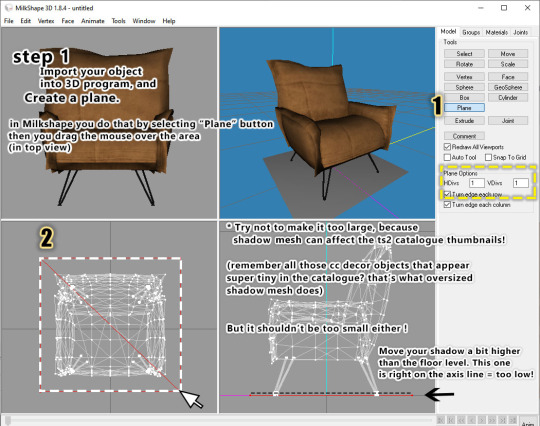
When exporting the models as .obj in SimPe, you need to tick the box next to shadow model, if you’d like to export it as well (SimPe will only export ticked models !) Then click Export... button.
Furniture clones have one groundshadow, and three or four vertical shadows - if that’s the case, I recommend you delete all shadows and create a new groundshadow plane.
Oversized shadow models are the cause of sh*tty thumbnails. If some objects in your Decor catalogue are so tiny you can barely see them, here’s why.
Remember to move the shadow plane up a bit, so it’s very slightly above the ground level.
Make sure you can see your object in wireframe view. Display options for Milkshape can be accessed by right-clicking inside viewport window.
When creating a plane, drag the mouse starting from top left corner, so UV’s are not rotated.
Rename your plane: “shadow“ or “groundshadow” etc, so SimPe auto-adjusts settings for it on import.
Blender 2.79b: Use Plane button, located in “Create” Tab. Remember to tick the “Create UVs” option before you create the shape. Switch to top view by pressing 7 on the num pad, press 5 to enable isometric view.
2., 3., 4.,

Now you can use this as an imprint for shadow. Remember to leave a tiny margin of 100% white around it!
5.

Gaussian Blur comes in handy ;)
You can (and it’s best that you DO) test your texture while you’re working on it.
Texture preview in Milkshape
Double-click the shadow plane in the Model tab. Go to Materials tab, click New button, then Assign. Click on the elongated button that says <None> (there are two of those, click the upper one) and load your texture. You can reload the texture by going to Edit menu, and Refresh textures.
If shadow looks off, you might need to rotate the plane 180* (or UVs, if you know how).
Blender 2.79b: I’ve described the quickest way to preview texture HERE.
6.

Note1: you don’t have to save the image as PNG just to preview it, Milkshape (and Blender ofc) can read PSD files.
Note2: obviously, if you didn’t create your own shadow plane, and the one you have inside GMDC works fine, you don’t need to export it.
7., 8.
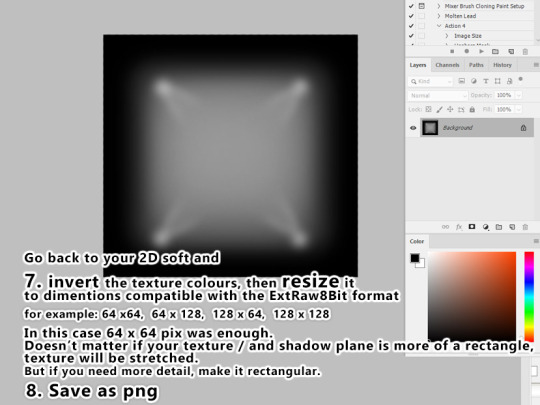
As I mentioned in the next pic, your .png has to be the same size as the shadow TXTR you’d like to replace. If you wish to change the shadow texture size, that’s described in the second part of this tut. Check out the pic 5 below.
9. Open SimPe and import new texture.
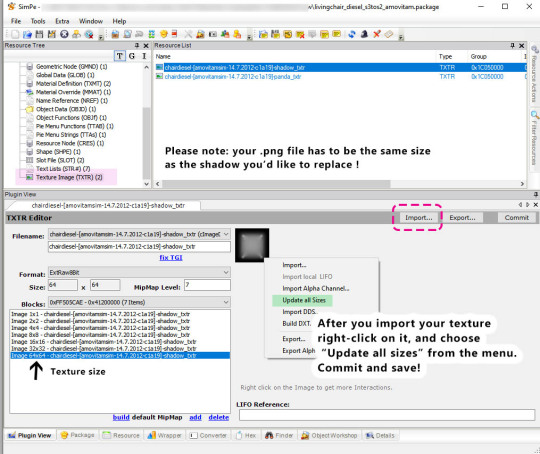
If you don’t “update all sizes” you’ll get funky effects in the game, shadows might change the shape or disappear when you zoom out.
Finished! Or almost finished.
If you’ve created your own shadow model (or edited the old one) there’s one more thing you need to do.
10. Import the shadow model into GMDC. If you don’t know how, look at the pic 1 below.
After you test the shadow in the game, and it’s too dark or not dark enough, you might want to edit the shadow intensity in SimPe - that’s super easy. Look at pic 3 below, in the second part of this tut.
✦ ✦ ✦ ✦ ✦ ✦ ✦ ✦ ✦ ✦ ✦ ✦ ✦ ✦ ✦ ✦ ✦ ✦ ✦ ✦ ✦ ✦ ✦ ✦ ✦ ✦ ✦
Shadow tutorial, Part 2:
What to do if shadow resources are missing
Not a beginner level stuff, but if you are resourceful, have a go at it.
Shadow, as any other subset, requires a few resources to work properly: Model in the GMDC and shadow TXMT settings that point to the right texture. It’s also essential to link shadow subset (model name) to a TXMT through SHPE.
If a TXTR or TXMT resource is missing, you need to add it. You have 3 options:
link your model to TXMT resource from another package through SHPE. Useful if you do repo objects that are all the same shape, only different sizes.
clone existing non-shadow resources and customize them
add shadow resources extracted from another package and edit the CRES name part
And it’s a good practice to add shadow name to tsNoShadow in the GMND, so it doesn’t cast shadows when outdoors. But that’s optional.
1. & 2.
GMDC - How to import new .obj model, or replace the existing model.
GMND - How to fix square outdoor shadows.

If you don’t know how to add new item to GMND blocklist - tutorials on repository technique for object add-ons etc always cover that bit.
Mesh Group Importer settings
When you click “Import..” button in GMDC and load .obj file, Mesh Group Importer window pops up. If you’ve never seen it before, take some time to explore the import options - Opacity, and Action both have drop down menus.
Changing Opacity to Shadow is a purely cosmetic effect. But if you keep it Opaque, shadow in the game will be highlighted when somebody moves design tool over the object !
Action menu options are pretty self-explanatory. If you’d like to replace existing model, set it to Replace. Then open drop-down menu in the bracket below and pick the right subset.
To change the name of the model after it’s been imported, go to Groups tab in GMDC, click on the shadow and edit the Name: field. Commit the changes and save.
3. & 4.
TXMT - How to edit shadow intensity through TXMT settings
SHPE - adding resources
To correct shadow brightness, open Categorized Properties Tab in the shadow TXMT and look for the line “stdMatAlphaMultiplier”. If it’s set to 1.000000, shadow’s usually pretty dark. To make it softer, you need to lower this number. 0.650000 is a good starting point.

If you add the entire TXMT shadow resource extracted from another package (not to be mixed with importing TXMT properties, it’s a different thing) you need to edit the name twice - in Filename field, and cMaterialDefinition tab.
If shadow looks like a solid object in the game that means it is linked to TXMT with wrong properties (shadows require specific TXMT properties) or texture that is not ExtRaw8Bit format.
Instead of trying to edit the TXMT properties, you can import the shadow properties from another package. If you don’t know how to do that, HERE is a little tutorial
TIP: the game only displays groundshadows for certain objects when placed indoors, and southwall shadows (wall shadows) only when all walls are up. If you change shadow subset name (in GMDC and SHPE), shadow will always be visible indoors, and outside (custom shadow names).
Remember, it’s essential you always do fix TGI after editing txmt or txtr name. But in case of adding or editing the SHPE parts (listed subsets) - don’t bother, because fix TGI doesn’t matter here. Stuff should work as long as you get all the names right and commit the changes.
Some old tutorials might tell you to FIX INTEGRITY after editing TXTR, SHPE, GMDC, TXMT. Don’t do it - it’s not required, and it can even break objects.
5.
TXTR - How to change format / size
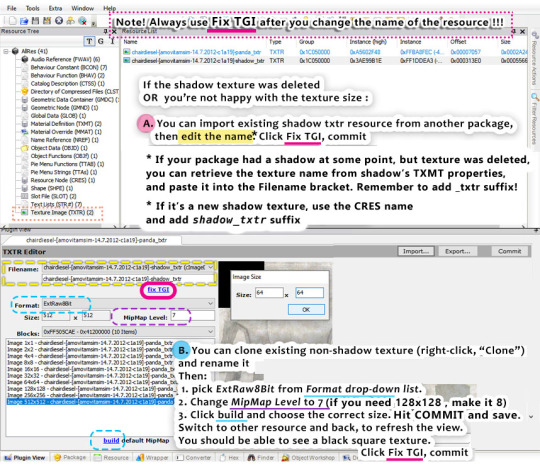
Note1: For a 64 x 128 pic shadow txtr (vertical), or 128 x 64 (horizontal) use MipMap Level 8.
Note2: obviously you need to select TXTR resource to fix TGI for it.
It’s not required for shadow texture to have “shadow_txtr” suffix, it could be “groundshadow_txtr” of anything else.
If you’ve created/added new TXTR, remember to update texture name in TXMT Properties and TXMT File List.
If you think you did everything right, but shadow is blue.. Well, something is NOT right ;) It could be wrong TXMT name or texture name.
Check your object with Scenegrapher. It looks quite complicated but if some resources are “orphaned” = not linked to anything, you’ll see it right away. Make sure you’ve run Fix TGI on edited TXMTs and TXTRs. It’s possible you have a typo somewhere. Start with screening the resource names for missing suffixes, like _txtr or _txmt. Then check the texture names - make sure you haven’t added a suffix somewhere where it’s not required.
✦
117 notes
·
View notes
Text

heres some of those icons i made last night in context… each station map will probably consist of a flat diagram like above, a smaller isometric diagram shown below (along with station traffic flow or other info when its relevant),


and a surface map showing exits and nearby connections (note that this one is just a screenshot of osm lol. i will probably use osm data but i’ll actually mess w it in qgis so i only show whats relevant)
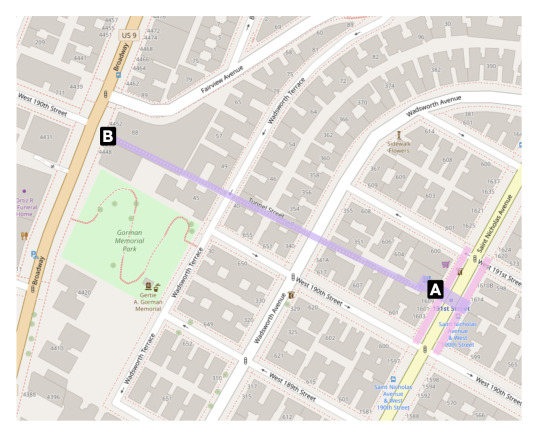
this is loosely based on station maps from the helsinki metro (the diagram on my previous post was also from helsinki), but my goal is to make it easier to read bc many stations here are larger than anything in helsinki…

to be clear i wont be doing every station on the subway lol but i do want to do a handful of these and i may attempt to do 42nd st just for fun so i want some amount of scale-independence build in.
please do lmk if you have thoughts about this… i am curious to know whether ppl think the information im providing is adequate for navigation or whatever. the station above is 191st on the 1 train (i did it from memory though so no promises its exactly right)
#i would have done an accessible station but i know 191 really well bc im there all the time#also the iso diagram may not be necessary in a station this small but i think it could be helpful#just to identify what floor youre on and how they vertically stack in more complex stations#i may have to change the angle though#transit maps
3 notes
·
View notes
Text
SwimCity 2000 Postmortem
I didn’t have a lot of time this Ludum Dare, so I tried to make the simplest thing that is still a complete and playable experience, taking up no more than fifteen minutes.
Download here: https://blubberquark.itch.io/swimcity-2000
LDJAM submission: https://ldjam.com/events/ludum-dare/50/swimcity-2000
Day 1
I knew in advance I would be a bit short on time that weekend, so after very little brainstorming, a city builder where the water rises beat out other ideas like an inverted Downwell where you climb faster than an advancing wall of doom. I generally try to avoid games that could have fit previous LD themes, so I didn’t want to do anything where the player would be running put of space, or going deeper and deeper, et cetera.
Based on these considerations, I decided on a city builder, and because rising water was going to be a main game mechanic, I knew I’d need to either make it it in true 3D, with a side-view (think Oxygen Not Included), or with isometric graphics. I have written isometric renderers before, one of them just to illustrate a tumblr post, so I knew I could do that quickly.
I decided to model my graphics on SimCity 2000, which was mostly the original SimCity formula, but with isometric graphics - and much, much more stuff in it. You could raise the terrain, flatten mountains, and excavate valleys.
I drew some 32x32 terrain tiles in aseprite, with the default db16 colour palette. Looking at SimCity 2000 for guidance, I realised that this old game looked super washed-out and ugly, and I was confident I could do better!
Based on the terrain I remembered from SimCity 2000, I decided that the elevation of the map could only go up one level per tile. This ensured I did not have to draw dozens of different slope tiles. I then decided that the map would not be represented as tiles, but as elevations of grid points. Tiles would be selected from a dictionary based on the relative elevations of their corner grid points. This way, it’s impossible to place incompatible tiles next to each other. I ruled out certain cases to make sure my tile selection thingy that was somewhere between marching squares and marching cubes would not be too difficult to implement. In a “full game”, I probably would not constrain the level design this way to make implementation easier or reduce the number of pixel art assets.

Then I drew the tiles in a semi-submerged state, and put everything together in a simple rendering demo where I could raise and lower the global water level.

That was day 1.
Day 2
After a false start trying to pre-compute flood basins, I decided to simulate water levels based on grid points, and to store buildings per-tile. The water simulation would run every tick, equalising the water levels between adjacent grid points, and the tile renderer would pick tiles based on the averaged water levels of all four grid points, in addition to ground elevation.
This worked, kind of, but it was invisible to the player. Every tick, every grid point was updated, but it just worked out like a global water level in practice. In order to show the player that something was happening, I added particle effects for the water flow.

This worked a bit better. Instead of raising and lowering a global water level, my demo now increased or decreased the local water for all tiles, and you could see the water flow to equalise the level again.
I had expanded my demo level a bit, with an interesting basin in the north corner, which would fill up faster than the open plains in the centre, and some high-elevation plateaus in the south-east,
Next I implemented buildings. Instead of having buildings placed on grid points, I decided to place them on tiles, in a separate data structure. That makes one data structure to store elevation (grid points), one for particles (world space), one for water levels, and one for buildings (tiles between grid points).
I added a special rule in the water flow simulation that prevented water from flowing over dams, if the dam way between grid points and higher than the water level.
Then I worked on the UI. At first, I tried a simple approach to picking tiles with the mouse cursor, but that did not work well. Different tiles have different shapes, and then there are buildings. There is no simple and accurate way to select a tile. I side-stepped this problem by doing drawing and picking in a single pass (for details. look at this tumblr post).
After trying to implement some procedural generation, I quickly scrapped that idea again. I couldn’t reliably get the system to generate interesting features that would flood the way I wanted it.
Day 2 was cut short again. I think I needed to shovel snow.
Day 3
I had a cool water simulation and some buildings, but no real gameplay. I was already a day late. I decided on some really simple city building mechanics. My goals were:
The game is visibly a city builder inspired by SimCity 2000, not just a flooding sandbox
The simulation is tile-based, without fancy agent-based stuff.
You can’t win, the city will eventually be submerged in water
The mechanics are simple and forgiving. You don’t need to understand how they work, you can just build stuff and figure it out.
There is only one resource and one metric.
The first set of rules that I tried worked reasonably well.
Start with $100
Residential zones cost $20
Commercial zones cost $50
Dams cost $10, $10, $20, $30, $40, and so on
Residential zones have a fixed spawn chance, commercial zones spawn chance increases with spawned residential buildings
Roads and zones can only be built next to roads, dams can be built everywhere
The last rule made it work: Everything needs to be connected to the road network. Once there is water on the roads, it’s only a matter of time before EVERYTHING is flooded!
It took me a couple of playthroughs to tweak the speed at which water flows in, the spawn rate of particles, and the timing of revenue collection.
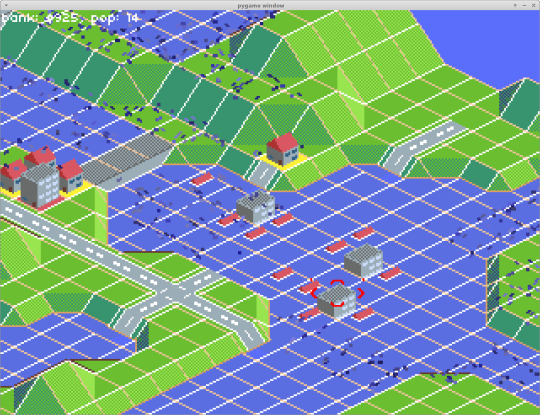
There is no real meat to the gameplay, but by the time you figured out what you need to do, the flooding has already started, and you find yourself making a decision between growing your city, building the dam higher, and increasing your revenue in the short term. This means you play the game twice, and get to a population of 50 or so in the second playthrough (and 80 to 100 in the third, but that’s just showing off).
You start with your first roads and buildings near the water, but elevated by one level, so you have to move away relatively quickly, but you also won’t completely drown right away.
What went right
I am pleased with the way I used the theme. The flowing water slowly rising spells doom from the start.
I also like the look of my isometric pixel art graphics. It looks really pretty, brighter than the original SimCity 2000. I got a lot of positive feedback.
I like that the design is simple. It’s about only one thing, and it does not distract from that. The city building has only for things to build, but they all work well together.
The title. You have to admit it’s funny!
What went wrong
The water simulation is really janky. I spent a lot of time on dead ends, and the way it works now is really hacky and janky. It is basically the simple water simulation I wrote after the flood basin pre-computation, with some added special cases. I lost a lot of time making it work.
I forgot to add a “tweet this“ button to the game over screen, as well as the Blubberquark Software title card. I didn’t even add controller support in a post-compo build.
The actual city building is really sparse. There is nothing cool to look at, no cutesy “Wuselfaktor” like in Die Siedler II, no building properties to inspect. I could have remedied this somewhat by making more “empty“ tiles with grass, rocks, and different trees, or different-looking building variants with no gameplay differences, but I didn’t make enough time for that.
The particle effects of the jam version give the game some much-needed legibility, but they also slow down the simulation and they aren’t properly culled or occluded, often making it harder to see what’s going on.
It wasn’t clear in the UI when tiles update and taxes are collected (every ten seconds).
I spent hours trying to make certain ideas work before I went back to the simplest possible solution.
What I learned
Making an isometric city builder from scratch is not much more difficult than making a platformer, but it is much easier to balance a platformer than a puzzle game. Balancing a city builder takes so much time.
Getting your data structures right in the beginning is more important than the algorithms. I knew that already, but I foolishly disregarded it.
Procedural generation in a game jam is a waste of time, unless 1. the level you want to generate is bigger than you can manually design in such a short time or 2. the game is supposed to be re-played a lot even as a jam game or 3. the generation is super simple.
Python is really not made for this kind of game. I am running into insurmountable performance problems at certain map sizes. It would have been fine if the game was completely turn-based, or if updates happened at a slower time scale, but as-is, the simulation runs every frame, drawing runs every frame, and there is no straightforward way to have the simulation run in another thread. The problem is not the software rendering of PyGame, but the way the water levels are updated. Even NumPy would not help much, because there is no function in NumPy that does the thing I want, so I could at most use a NumPy array to store the data, but operate on it in pure Python code (no releasing the GIL). Speeding up rendering, for example by rendering the terrain in a shader, would free up CPU resources though, even though it wouldn’t allow utilisation of more CPU cores.
Still, updating every tile every frame is more flexible than pre-computing flood basins and re-computing them when dams are changed.
Performance was surprisingly important, because I needed to try out different (unoptimised) water flow systems.
Future Plans
I knew going in that I wouldn’t make this into a “full“ game, and built something that relies on a single gimmick for short experience. Eleven of the Ludum Dare games I worked on (22, 30, 32, 33, 36, 40, 41, 43, 46, 47, 50) were not designed to be “finishable“ into a “full“ game.
I have made my peace with this. I don’t want to work on another “big” game anyway; I am working on an unannounced big game that did not start in a game jam. Even if I wanted to work on a city builder from a game jam, I would probably try to focus on Deep Sea Settler first.
If I wanted to make SwimCity 2000 into a “full” game, I would have to tone down the water simulation, and make flowing water one mechanic among many. The whole “delaying the inevitable“ theme would have to go. The main focus of the game would have to be changed from stackable dams to something else. The design only really works because of the theme, and because it’s a jam game. Expanding it would mean completely overhauling the main loop and all game mechanics.
And yet, I got positive feedback telling me to keep working on this! Friends told me that SwimCity 2000 isn’t that fun yet, but it’s interesting and I could make something of it. I really don’t think so. A game that takes two hours per game, broken up into multiple play sessions, needs something other than a single gimmick to keep it going.
At most, I could see a campaign of ten different cities, where each one has a different type of challenging geography, with water flow only one mission of the ten. And then I’d need to balance the game mechanics for those other challenges, and make the game interesting without the “hunger clock“ of rising water levels.
That said, I can see these potential futures for SwimCity 2000:
City Builder: Tone the water simulation way down, add dozens of buildings, zones, utilities, tile stats, and some agent simulation, and make something that is basically SimCity 2000, but lighter and more game-ey and less sober city simulation. Add different sizes of buildings, different sizes of roads, streets, and highways, trees, different biomes. Definitely add the ability to tear down buildings and change the terrain (at a steep cost). Dams cannot be stacked higher than 2 units any more.
Disaster City Builder: Keep most of the water stuff, add fire, meteors, King Kong generic non-trademarked giant gorilla, aliens, viral outbreaks, football hooligans, the Boston Molasses Flood of 1919, and other disasters. Just add some building types and city sim things, but focus on general mayhem. This option lets me keep the spirit of the current game. Maybe the water simulation could have momentum, and then we’d have tsunamis. Or landslides...
God Game: Make the city development automatic and focus on sandbox/terrain stuff. Somebody suggested this in the Ludum Dare comments, but I think this is basically just Populous. I never played it, but I know it was the isometric precursor to Black & White.
Real-Time Strategy: Just take out everything except the terrain rendering and make something that is sort of like StarCraft or Age of Empires.
Something Completely Different: I don’t know, maybe a Monument Valley de-make, or a Naya’s Quest fan game, based on the isometric view.
32 notes
·
View notes
Text
Sonic’s Edusoft
Original Platform: Master System (Unreleased)
Original Release: Unreleased (Development around 1991)
Available to buy: No

A game that was in development at British developer Tiertex in 1991. This was in development as an official Sonic game with an agreement between Tiertex, US Gold and Sega. While it was officially licensed, it was never granted publishing approval so ended up being cancelled. This game was still in early development, but the main portions seem to have been completed.
As the name suggests, this is Educational Software starring Sonic. It was designed for the Master System. As the developers didn’t know what sections of Sonic would become series staples, it has no rings (you collect stars instead). You walk around a map screen, which actually looks really nice, like an isometric Green Hill zone, selecting activities to play. These are usually maths or spelling challenges.
In these, you will race against a challenger by answering questions. For the maths ones, it will ask you a maths question and you select the answer from a list of possible answers. If you get it right, Sonic will move one step forward, while if you’re wrong the opponent will do. Half way through the quiz you’ll get a different question where it asks for a multiple of X and it will scroll through some numbers, and you have to hit the right one.
The spelling challenges give you a list of up to 8 letters, you have to work out what word they spell and select them in the right order to spell the word. In the middle of these, there will be a challenge where you have to press A when you see two of the same letter (although it is possible that it will time out before actually showing you a correct answer). The words in the challenges are based on different topics like transport, food, animals and hobbies/sports.
I was quite impressed with the amount of options for setting difficulty, with 7 different levels for question difficulty and speed (although putting both on full makes it virtually impossible for the spelling challenges), and on the highest setting I struggled with a few things. I think it’s a pretty solid educational tool, and I’m quite surprised that it was never rethemed and released as a lot of effort seems to have been put into it.
The “rewards” for progressing are not so good, though, as the game gives you three simple minigames. There’s one with a half-pipe and a balloon which just didn’t work, a trampoline game which is a very basic version of Game & Watch Fire and an auto runner platformer which had obstacles which were difficult to see. I think these were at a very early point of development.
I think Sonic’s Edusoft is quite an interesting bit of Sonic’s history, it’s not a game I would choose to play, but it seems very well made for an educational game.
3 notes
·
View notes
Text
10 Games Releasing 2023 That I'm Most Excited About
2022 was a wonderful year for games for me. I've played a lot of games in my backlog, as well as new releases as they came out. It can be tough keeping up with all the games that are releasing, but there are quite a few that I have my eye out for this year. Some big, some small, and some in-between! While I won't be talking about all of these extensively on this blog (mayhaps in smaller posts though, who knows?), at the very I want to gush about these in the turn of the new year.
Like a Dragon: Ishin (PS4, PS5, Steam, Xbox One, Xbox Series X/S)
February 21st 2023

To think that it's only been a few years now since I've first jumped on the Yakuza bandwagon. While there's still a few of the games that I need to finish, I'm excited to take on this spin-off game. Will I absolutely die because I insist on button mashing? Yes. Will I lose my mind the minute I see Majima? Also yes. I’d love to finish out the rest of my backlog with Yakuza before February comes around, but I know that’s but a lofty dream.
Legend of Zelda: Tears of the Kingdom (Switch)
May 12th, 2023

If there is one thing that I have always enjoyed when it comes to Legend of Zelda, it's the lore and styling of the series. Link knows how to make an impact, even in his simple tunic. While I never finished Breath of the Wild due to my attention span being really bad at the time that this game released, there is a hope inside of me that I'll see this game through to the end. That and, I'm also hoping that they improved on the open world aspect to tie in more story.
Master Detective Archives: Rain Code (Switch)
2023

When it comes to adventure games, my absolute favorite genre are mysteries. I love being able to solve the big question behind what's happening. So while I should know better than to put all of my eggs into one basket, my hopes are very high that this game will scratch my ever constant mystery adventure game itch. Given that the people behind Dangan Ronpa are behind this game, it should at the very least be an interesting experience.
Fire Emblem Engage (Switch)
January 20th, 2023

Like a lot of the Fire Emblem fandom, when the first official trailer for Engage came out, I was not sold on the designs at all. It just felt too...gimmicky. But after the deluge of new character designs that have come out, along with just allowing time to settle in, I realize that I am generally excited to see what Fire Emblem has in store for us. Of course, it is still a mild excitement, given the disappointment that was the gameplay/map designs for Three Houses. Say what you will, while the story was very good, the tactics gameplay left quite a bit to be desired.
Mega Man Battle Network Legacy Collection (Switch, PS4, Steam)
April 14th, 2023

I have a soft spot for Gameboy RPGs. Growing up on Yu-Gi-Oh games, I just really love the styling of isometric views. While I don't have any nostalgia for Mega Man at all, I do want go play as many older RPGs that I can, especially those from the GBA era that I wasn't able to play in my youth. And perhaps, if I end up enjoying these games, it can show that fans want more from Capcom in terms of Mega Man RPGs.
Final Fantasy XVI (PS5)
June 22nd, 2023

I'm not what you would call a Final Fantasy fan. That's not to say that I hate the series or anything, but more that I've just...never completed a Final Fantasy game. The furthest I've gotten was with Final Fantasy XIV and I haven't played Endwalker yet (and probably won't, just because I'm burnt out on MMOs for the foreseeable future). But something about XVI is drawing my eye and I find myself very intrigued. Perhaps its the gruff main character, or the fact that his charge is unexpectedly murdered, meaning that some intense angst is bound to occur. Who knows?
A Space for the Unbound (PS4, PS5, Switch, Steam, Xbox One)
January 19th, 2023
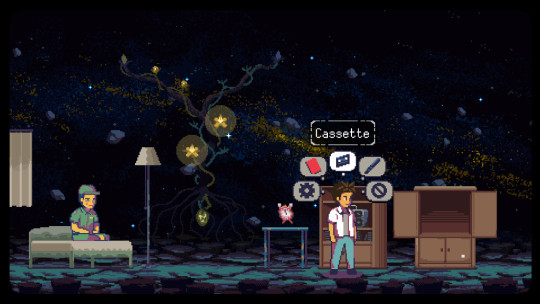
I remember playing this little indie demo about a year ago and loving the atmosphere behind it. The pixel art was gorgeous and I followed one of the developers of this title as they were posting about the game on Twitter. To see it finally be released has me very excited, especially so soon too.
Suikoden I and II HD Remaster: Gate Rune and Dunan Unification Wars (PS4, Xbox One, Switch, Steam)
2023
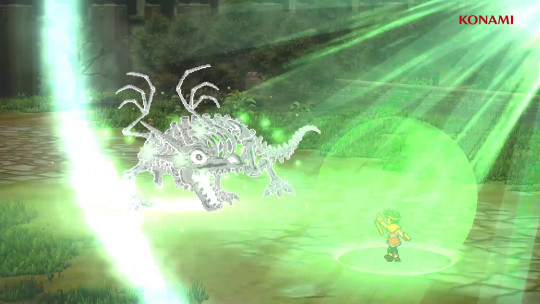
I'm very late to the classic RPG train, due to the fact that I never had the opportunity to play these games growing up. And I'm sure I'm not the only one who had thought this, but over the past...decade or so, Konami just left a bad taste in my mouth. From my perspective, it was the fact that they had so many IPs that they underutilized and those that they did milk (Yu-Gi-Oh) felt like low effort cash grabs. So seeing them actually putting an effort to developing and publishing games over the last few years has been a bit surprising. But hey, if it results in them opening their vault of old games and bringing them to more audiences, I'm all for it.
Have a Nice Death (Switch, Steam)
March 22nd, 2023
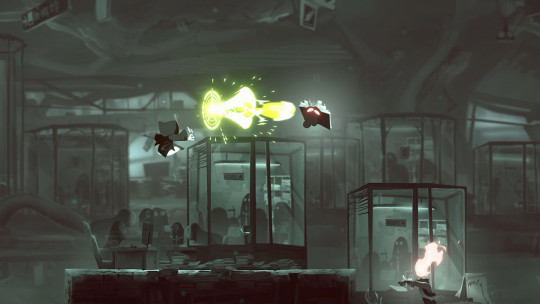
Roguelikes are a genre that I never imagined myself exploring until I played Hades. Now, I'm on the search for any other roguelikes that can scratch that satisfying itch of slashing through enemies, failing horribly, and getting back up and trying again (with some leniency since I'm bad at games). I'm not quite sure what to expect when coming into this game as I like to know as little as possible about new games I'm interested in (outside of the basics to make sure I'm actually interested in it).
Mineko's Night Market (Switch, Steam)
2023
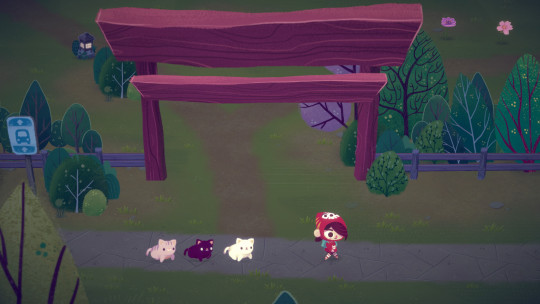
This is another indie title that I've had my eye on since it was first revealed in a Nintendo Indie Direct a couple years ago or so. Since then, it's been remaining low key, trickling out information every once in a blue moon. But now, it seems as though we are at the end of the tunnel, with a potential release date coming this year.
Those are just some of the games that I’m excited to play this year. But what games have your interest peaked?
#Like a Dragon: Ishin#Legend of Zelda: Tears of the Kingdom#Master Detective Archives: Rain Code#Fire Emblem: Engage#Final Fantasy XVI#Mega Man Battle Network Legacy Collection#A Space for the Unbound#Suikoden I and II HD Remaster#Have a Nice Death#Mineko's Night Market#video games#FluffyPrince Lists
4 notes
·
View notes
Text
GRANDIA 1: INITIAL IMPRESSIONS
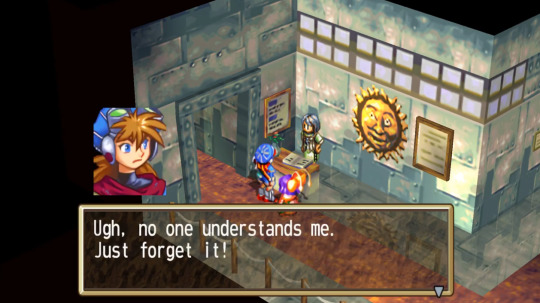
Tex impressions:
I liked it a lot! The English dub was dated and bad (and was, in fact, both of these things), but it was easy to switch off. I thought that the characters were fun and the dialogue was great. I like Justin and Sue a lot already, and we've only just gotten out of the Sult Ruins. I think they did a great job of bringing out the characters' personalities, and the Lunar-esque thing where characters respond to random NPCs' dialogue is fantastic.
I thought the combat system was fun, too. It doesn't have a lot of explanation, but the interactions with the turn order in quasi-real time -- and the ability to slow enemies' turns down and have yours slowed down or canceled -- made for fun fights, but not punishingly hard. I did a few more fights than I strictly had to.
I'm excited to see where it goes! Also, who the other party members are, and whether the Garlyle Forces are actually the bad guys or if they do a turn and become helpful down the line. I'm also excited to see what the world looks like, because the first dungeon (especially in the HD remake) was great.
Jellybi impressions:
After getting over the shock of the incredibly bad English dub (we ended up switching audio over to Japanese pretty quickly) I was surprised by the charm of this game! There's clearly a lot of love and extra effort that went into it. Portrait sprites look fantastic and have multiple expressions for different emotions, there's lots of little ways to interact with the environment, and we saw tons of bonus sprite animations even in the very early moments for minor things like searching around on the ground for an item. Things like that make the game feel more dynamic and full of possibility.
Another great point is that the characters talk back to NPCs during dialogue, making exploring towns an opportunity to see more of their personalities rather than just getting hints about worldbuilding or where to go next.
The characters so far seem cartoony in a good way, with memorable character designs and lively interactions. I'm curious to see more of the military organization, since it's not clear yet if they're meant to be villains or not. There's a trio of female commanders (that Tex dubbed Evil Magic Knight Rayearth) who definitely seem a bit villainous in presentation, but in a campy fun way, who I'd like to see more of.
Jellybi’s Impulsive Introductory Ratings:
Art rating: 4/5: Love the character portraits, and the isometric 3D look combined with 2D character sprites is charming and reminds me of Final Fantasy Tactics. The early 3D environments are occasionally a bit rough looking and there’s Something Deeply Wrong with the mascot character’s face, but there’s more I’m happy about than not.
Mechanics rating: 3/5: Occasionally a bit clonky. There’s a lot of exploration-based stuff in the beginning and it’s easy to wander to a new map accidentally because the exit areas aren’t well demarcated in the environment. I also found some of the menu navigation unintuitive (trying to equip items takes you to the trade menu instead if you’re not careful). Combat is still a bit mysterious to me, but fun, and some of the early character moves have unique and cute animations.
Dub rating: -5/5: Hilariously bad. Sounded like they rounded up random employees working on the localization script and made them do the voicework. Lines had this sort of low-energy, confused feeling. Were those actual professional voice actors? I’m afraid to know.
6 notes
·
View notes